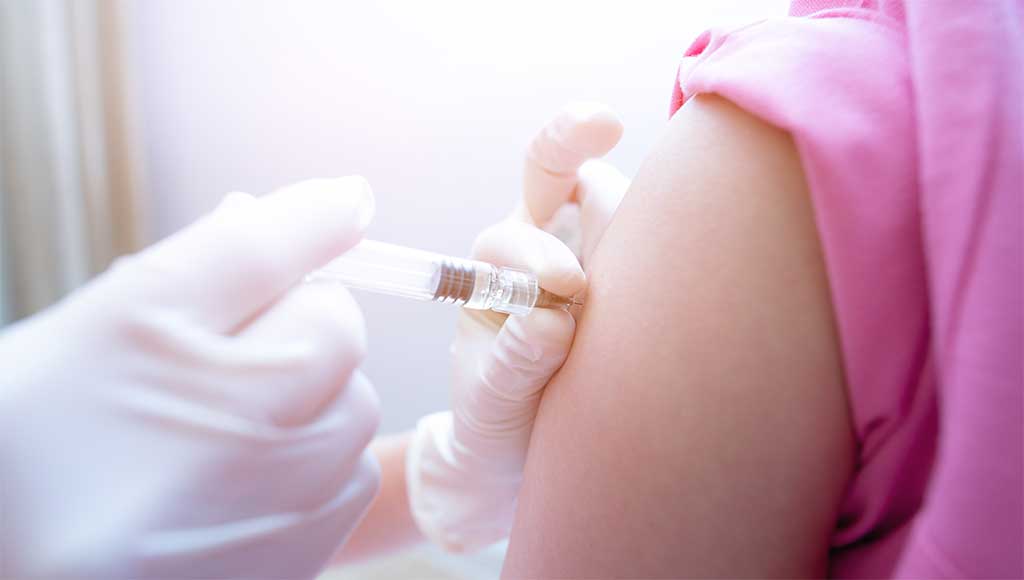
The National Health and Medical Research Council (NHMRC) recently published the ‘2021 Cervical Cancer Elimination Progress Report’. This is the first of what is intended to be a regular series of reports regarding the elimination of cervical cancer as a public health concern in Australia. The World Health Organization (WHO) defines cervical cancer elimination as an incidence of four per 100,000 women or lower. Elimination has not yet been achieved by any country. However, Australia is predicted to be the first country to achieve this goal, possibly as early as 2028.
Cervical cancer is a preventable cancer, with nearly all cases attributed to human papillomavirus (HPV) infection. This makes primary prevention with HPV vaccination so important. There are more than 100 types of HPV, around 40 of which are responsible for infections of the genital tract. Just two HPV types, type 16 and 18, are responsible for around 70% of cervical cancers. The remaining 30% of cases are due to other high-risk HPV types. These HPV types can also cause some vaginal, vulval, penile, and anal cancers. Low-risk genital HPV types such as 6 and 11 can cause genital warts.
The majority of HPV infections are asymptomatic and resolve spontaneously within 12 to 24 months. However, HPV infections that persist can cause abnormalities that may progress to cancer. It may take 20 years or more for cervical cancer to develop from HPV. Therefore, HPV vaccination programs do not have an immediate impact on the incidence of cervical cancer. Cervical screening remains an important component of the elimination strategy.
Australia was the first country with a national HPV vaccination program. The school-based program was rolled out to girls in 2007, with boys added in 2013. In 2018, the quadrivalent vaccine was replaced by the nonavalent vaccine, which protects against an additional five HPV types. The virus types covered in the nonavalent vaccine account for around 90% of cervical cancers, 95% of all HPV-related cancers in men, and 90% of genital warts in men and women.
The vaccine does not affect existing infection with a virus type contained in the vaccine. Therefore, the vaccine is most effective when administered before the recipient becomes sexually active. The Australian Immunisation Handbook recommends a dosing schedule of two doses, given six to twelve months apart for adolescents aged 9-14 years. A three-dose schedule is recommended for people 15 years of age and older and anyone with an immunocompromising condition. When a three-dose schedule is used, there should be an interval of two months between the first and second dose and four months between the second and third dose.
The HPV vaccine is generally well tolerated. A large-scale analysis of surveillance data reported to the Therapeutic Goods Administration (TGA) between 2007 and 2017 affirmed the safety profile of the quadrivalent HPV vaccine. The range of adverse events reported is similar in males and females and includes headaches, fever, nausea, dizziness, and fatigue. Rates of anaphylaxis are low and comparable to other vaccines. Syncope has been identified in post-marketing surveillance to be a common adverse effect following HPV vaccination in adolescents. This is a benign reaction to the process of vaccination rather than the vaccine itself. Procedures should be in place following vaccination to minimise the risks associated with syncope-related falls.
The ‘2021 Cervical Cancer Elimination Progress Report’ provides an audit of HPV vaccination coverage as part of Australia’s overall progress towards the elimination of cervical cancer as a public health problem. Some of the key findings of the report include:
- Completion of HPV vaccination by age 15 occurred in 78.2% of adolescents in 2019 (79.6% of females and 76.8% of males);
- The rate of HPV vaccination is close to what is predicted to be required for the eventual elimination of vaccine-preventable HPV types (80%). However, the rate for vaccination of girls is currently below the 90% target set by the WHO; and
- The incidence of cervical cancer in Australia is 6.3 new cases per 100,000 (from 2011 to 2015);
- Indigenous women suffer cervical cancer at twice the rate of non-Indigenous women and have a three-fold higher mortality rate.
While the overall incidence of cervical is low in Australia, there are considerable inequalities for Indigenous Australians. This inequality may be related to lower uptake of the vaccine and poorer access to treatment. Uptake of routine screening may also be a contributing factor, although screening data based on Indigenous status is not included in the report due to a lack of data. The next report in the series is expected to provide meaningful data on this indicator.
Addressing these inequalities is one of the main recommendations noted in the report. Other recommendations include improvements to data collection and the development of a methodology to monitor cervical cancer treatment rates. The NHMRC Centre of Research Excellence in Cervical Cancer Control is optimistic that the issues identified in the report can be addressed to ensure that Australia advances towards eliminating cervical cancer as a public health problem for all women.
References:
- Cancer Council Australia. The HPV vaccine. Melbourne: Cancer Council Victoria; 2019.
- Gardasil® 9 (Human Papillomavirus 9-valent Vaccine) Australian approved product information. Macquarie Park: Merck Sharp & Dohme. Approved February 2021.
- NHMRC Centre of Research Excellence in Cervical Cancer Control. 2021 Cervical Cancer Elimination Progress Report: Australia’s progress towards the elimination of cervical cancer as a public health problem. Melbourne: NHMRC; 2021.
- Phillips A, Hickie M, Totterdell J, Brotherton J, Dey A, Hill R, et al. Adverse events following HPV vaccination: 11 years of surveillance in Australia. Vaccine 2020; 38(38): 6038-46.
Subscribe Knowledge Centre Updates
Enter your details to receive Knowledge Centre updates
